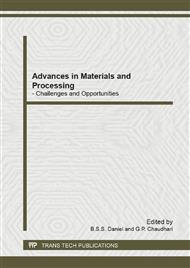p.110
p.115
p.120
p.124
p.129
p.134
p.139
p.144
p.149
Morphological and Luminescence Study on Eu3+ Doped ZnO Nanoparticle Prepared by Hydrothermal Method
Abstract:
Undoped and Eu3+doped ZnO nanostructure were successfully grown under hydrothermal method and europium doping concentration were varied as 1, 3 and 5 (at %). All the peaks in the XRD diffraction pattern are assigned to the typical hexagonal wurtzite structure of ZnO. Average crystallite size was calculated from scherrer formula and it indicated an increase in crystallite size with doping concentration. Scanning electron microscopy (SEM) for undoped and 1% doped samples shows spherical shape particles whereas for higher doping concentrations (3 and 5 at %), rod shaped particle are observed. The presence of Eu was confirmed by Energy dispersive X-ray analysis (EDX). Fourier transforms infrared spectroscopy (FT-IR) spectra are used to identify the strong metal oxide (Zn-O) interaction. Ultra violet visible (UV-vis) spectroscopy indicted an absorption peak at 375 nm. Red emission peak in photoluminescence (PL) spectra at 642 nm arises due to intra 4f-5d transition in Eu3+.
Info:
Periodical:
Pages:
129-133
Citation:
Online since:
November 2012
Authors:
Keywords:
Price:
Сopyright:
© 2012 Trans Tech Publications Ltd. All Rights Reserved
Share:
Citation:


